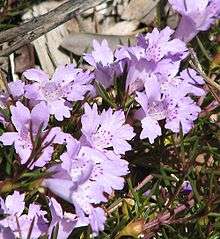Hemiandra
| Hemiandra | |
|---|---|
 | |
| Hemiandra pungens | |
| Scientific classification | |
| Kingdom: | Plantae |
| (unranked): | Angiosperms |
| (unranked): | Eudicots |
| (unranked): | Asterids |
| Order: | Lamiales |
| Family: | Lamiaceae |
| Genus: | Hemiandra |
Hemiandra, commonly known as snakebush, is a genus of plants of the family Lamiaceae, first described in 1810. The genus is endemic to Australia (Queensland and Western Australia).[1] They are all prostrate to smallish shrubs allied to Westringia. The red, lilac, pink, or white flowers are 2-lipped, the lower lip enlarged and spotted. The stiff, narrow leaves often have prickly tips. The Hemiandra is a genus holding eight varieties, one being a mauve-colored flower native to Western Australia. More specifically in Avon Wheatbelt, Esperance Plains, Geraldton Sandplains, Jarrah Forest, Mallee, Swan Coastal Plain, Warren (Hollister). Despite living in such a limited area, the flower is not considered to be threatened to becoming endangered (Australian Native Plants). The Hemiandra family is the Lamiaceae, in the Lamiales order, within the Plantae kingdom. The Hemiandra scientific name is the Hemiandra Pungens, but its common name is the snake bush (Botanic Gardens of South Australia). The plant received its name of the snake bush due to frequently being used as a groundcover plant for embankments, nature strips, and roundabouts, creating a perfect habitat for snakes shelter. As a groundcover, the plant is also useful for the control of soil erosion and a barrier in heavy traffic areas due to its prickly foliage (Botanic Gardens of South Australia). The bush has thorns around the stem for protection from predators, but snakes can easily maneuver around them. The flower ranges in hues of bright, warm colors such as yellow, red, pink, purple, and white with dots or stripes in the throat of the flower. The Hemiandra is frequently found to be about three to six inches tall and twenty to thirty inches wide. Leaves are about twenty millimeters wide and are usually simple lance-shaped with a short sharp point. Hemiandra’s tend to attract not only snakes, but bees as well. They are tubular flowers with a myriad of pollen and nectar to appeal to bees (Angus). Keeping this in mind, Hemiandra’s are a phenomenal choice for personal gardens, especially if you are looking to produce honey. “It’s perfect for pots and hanging baskets and makes for an excellent rockery plant” (Angus). There are five different varieties of the plant with minimal differences such as hairiness, color, leaf size, and floral features. The Hermiandra Pungens, the main species, is the most popular one and is an offspring form of the variety Glabra (Australian Native Plants). This has stems and leaves without hairs and pink flowers and spreads to about one meter diameter. Despite being the most popular variety, seeds are difficult to find although the flower is easy to breed. “Using a related species such as Westringia fruticosa (as has been done with Prostanthera species) may be worth trying to extend the range of cultivation of the species” (Australian Native Plants).
- Species
- Hemiandra australis B.J.Conn ined.
- Hemiandra bellairsiana B.J.Conn ined.
- Hemiandra coccinea O.H.Sarg. - Western Australia
- Hemiandra gardneri O.H.Sarg., Red Snakebush - Western Australia
- Hemiandra glabra Benth. = Hemiandra pungens R.Br
- Hemiandra hancocksiana B.J.Conn ined.
- Hemiandra incana Bartl. - Western Australia
- Hemiandra leiantha Benth. - Western Australia, Queensland
- Hemiandra linearis Benth., Speckled Snakebush = Hemiandra pungens R.Br
- Hemiandra pungens R.Br., Snakebush - Western Australia
- Hemiandra rubriflora O.H.Sarg. - Western Australia
- †Hemiandra rutilans O.H.Sarg. Colourful Snakebush - Western Australia but extinct
Cultivation
They need very well-drained, preferably sandy soil and prefer a sunny spot, although they will tolerate some shade. They prefer drier, temperate zones and need only be watered sparingly. Prune regularly to keep them tidy and to prolong flowering. Propagate from fresh seed or cuttings. They are prone to fungal diseases in humid conditions. Some success has been had by grafting them onto Westringia stock. They can spread from sixty to eighty feet across the ground, normally blooming in Summer but sometimes starting in late Spring depending on temperatures (Angus). Hemiandra’s are flexible in the type of soil they grow in consisting of clay, gravel, loam, and sand. They tend to bloom best in a cool, semi-arid climate, although they tolerate drought and moderate frost. Hemiandra’s can also handle environments containing heavy water, allowing them to be pipe and drain friendly and can be found poolside (Angus). They require minimal watering but bear excessive amounts, although providing too much water and sun can kill the plant. Hemiandra’s are considered evergreen plants, providing viewers with an abundance of greenery when blooming, rather than having deciduous leaves (Australian Native Plants).
References
- "Hemiandra". FloraBase. Western Australian Government Department of Parks and Wildlife.
Angus. “ Hemiandra Pungens – Snake Plant.” Gardening With Angus, http://www.gardeningwithangus.com.au/hemiandra-pungens-snake-plant/ “Hemiandra Pungens.” Australian Native Plants, www.anpsa.org.au/h-pun.html. “Hemiandra Pungens.” Botanic Gardens of South Australia, plantselector.botanicgardens.sa.gov.au/Plants/Details/749. Hollister, Chris, and Kevin Thiele. “FloraBase-the Western Australian Flora.” Western Australian Herbarium, Biodiversity and Conservation Science, Department of Biodiversity, Conservation and Attractions, Western Australian Herbarium, Biodiversity and Conservation Science, Department of Biodiversity, Conservation and Attractions, 29 Aug. 2017, florabase.dpaw.wa.gov.au/browse/profile/6839.